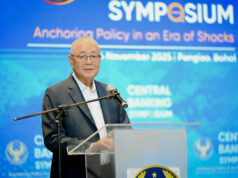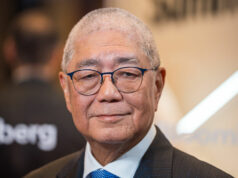Consumer prices pick up further in April to breach full-year target
By Christine Joyce S. Castañeda, Senior Researcher
THE RISE in prices of widely-used goods picked up to its fastest pace in more than five years in April, fuelled by sharp increases in food and “sin” products, the government reported on Friday.
Preliminary data from the Philippine Statistics Authority (PSA) showed the consumer price index (CPI) in April rose 4.5%, faster compared to the 4.3% in March and from the 3.2% logged in April 2017. Headline inflation clocked 4.1% year-to-date, breaching the government’s 2-4% target for 2018.
Last month’s print was the fastest in at least five years as computed under the 2012-based CPI, according to available PSA data.
The result matched the median estimate in a BusinessWorld poll of 11 economists conducted last week and was within the 3.9-4.7% forecast range for the month given by the BangkoSentral ng Pilipinas’ (BSP) Department of Economic Research.
“The April actual data is on the high side of our forecast for the month. At the same time, we note the deceleration of the seasonally adjusted month-on-month inflation,” BSP Gov. Nestor A. Espenilla, Jr. said in a statement sent to the media on Friday.
“These are relevant factors to consider at the policy review next week in determining the necessity and shape of a measured response to halt potential build up in inflationary expectations. Such expectations seem to be feeding off essentially cost-push price pressures that may be transitory in nature,” the central bank governor added.
On a month-on-month basis, consumer prices grew 0.519% in April, slightly lower than the 0.522% growth in March.
For Socioeconomic Planning Secretary Ernesto M. Pernia, “[t]he current surge in inflation is partly an initial reaction to the implementation of TRAIN (Tax Reform for Acceleration and Inclusion law) and is expected to be short-lived and should taper off over the coming months,” he said in a statement by the National Economic and Development Authority (NEDA), of which he heads as director-general.
The “more important sources” of the price upticks, however, were the combination of the increase in world oil prices and the depreciation of the peso, the NEDA statement further read.
Economists shared Mr. Pernia’s assessment.
Ruben Carlo O. Asuncion, chief economist at UnionBank of the Philippines, noted the increase in the prices of various commodities which include, among others, “sin” products, transport services, and utilities.
“[I]t is also very important to point out that the food index at the national level has eased, month-on-month. This might also be the reason why inflation upward pressure has slowed, month-on-month,” he added.
According to PSA data, a double-digit increase was recorded in the alcoholic beverages and tobacco subindex at 20% year on year, picking up from March’s 18.6% and 7.4% in April 2017. This was the subindex’s fastest since December 2013’s 30%.
Other commodities that contributed to the price pickup last month were transport (4.9%); restaurant and miscellaneous goods and services (3.4%); housing, water, electricity, gas and other fuels (3.0%); furnishings, household equipment and routine maintenance of the house (2.8%); health (2.8%); clothing and footwear (2.2%); and recreation and culture (1.5%).
The growth in the prices of food and non-alcoholic beverages was steady from March albeit remaining elevated at a 5.9% rate. This was, however, still higher than the 3.3% recorded in April 2017.
Angelo B. Taningco, economist at Security Bank Corp., noted April inflation being “partly driven” by food price inflation “as showcased by sharper price increase in rice and still elevated price upswings in meat, fish, fruits, and vegetables.”
“We think food supply disruptions may have induced food price inflation during the month,” the economist said.
The food alone index, eased to 5.5% from the 5.7% in the previous month, but faster than the 3.6% in the same period in 2017.
Among prices of food items, price of rice picked up by 4.3% in April from March’s 3.6% while that of meat (5% from 6.1%), fish (12.3% from 12.9%), fruits (6.7% from 7.1%) saw decelerations from the month prior. Prices of vegetables, meanwhile, were up 6.8% in April from 6% in March.
INFLATION TEMPORARY
Economists, as well as the BSP, were in agreement that the surge in consumer prices will be temporary.
“While average inflation has already exceeded the government’s target as of April 2018, the surge is temporary and seen to normalize towards the end of the year,” NEDA said in its statement.
For Michael L. Ricafort, economist at the Rizal Commercial Banking Corp.: “Inflation could reach the peak around (the third quarter of the year) and could start to normalize lower upon crossing 2019, exactly a year after the implementation of the TRAIN.”
ING Bank Manila branch senior economist Jose Mario I. Cuyegkeng said inflation could peak at around 4.8-4.9% this month or in June.
“Like the BSP, we expect inflation to return to within the target range in 2019, but if expectations are not contained, this could lead to firmer-than-expected inflation. We expect BSP to hike policy rates by 25 (basis points) at the May 10 meeting,” Mr. Cuyegkeng said.
“This would also support PHP (Philippine peso) and help moderate inflation pressures. We expect another rate hike in [the fourth quarter] while BSP keeps a hawkish tone in between rate hikes,” he added.
For, ANZ Research analysts ShashankMendiratta and Sanjay Mathur said the inflation trajectory, accompanied by strong imports and credit growth, “warrants a rate hike.”
“Our base case is that the BSP will maintain its policy rate at 3.00% next week. However, over the past few days, the central bank has suggested that it is prepared to take appropriate measures to protect price and financial stability, thereby raising the odds for a rate hike,” they said.
Meanwhile, Security Bank’s Mr. Taningco expects inflation to pick up further in the months to come and may breach the 5% mark amid base effects.
For his part, Cezar P. Consing, president and chief executive officer at the Bank of the Philippine Islands (BPI), noted that inflation could “come off” if the government would liberalize rice imports, and if oil prices would stabilize.
“But equally important, I think the central bank has shown to be more hawkish… If the central bank acts on policy rate, that would help too…,” he said at the sidelines following a bell-ringing ceremony at the Philippine Stock Exchange on Friday.
“Remember when the central bank said the inflation would peak and then come off? I think they might well be right,” he said. — with inputs from Melissa Luz T. Lopez and Karl Angelo N. Vidal



